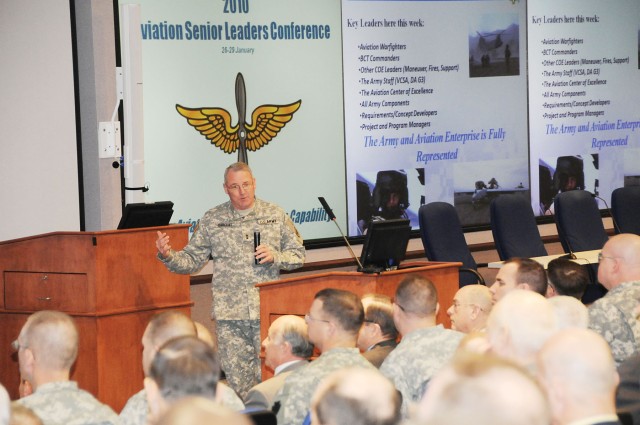FORT RUCKER, Ala. - Nearly 300 leaders, including 28 retired general officers and 14 current general officers, descended onto Fort Rucker for the 2010 Aviation Senior Leaders Conference, Jan. 26-29.
The theme "Army Aviation: A Full Spectrum Capability," was given by the Chief of Staff of the Army, George W. Casey, to reflect where we're going as a branch, said Maj. Gen. James O. Barclay III, U.S. Army Aviation Center of Excellence and Fort Rucker commanding general, during the opening statements, Jan. 26, at the Seneff Center.
"Full spectrum operations for the Army is something the CSA is pushing for the entire Army," said Barclay.
"Full spectrum Aviation is meant to describe the fact that our Combat Aviation Brigades are designed to be able to deploy and fight in any type of conflict," said Mark Hayes, Senior Analyst for the Capabilities, Development and Integration Directorate, Fort Rucker. "This can be a major combat operation, a counter insurgency, peace keeping, homeland security or disaster relief mission. Our intent is to be able to react without changing how we are organized."
To reflect this goal, senior Aviation leaders, along with leaders from other branches, took part in panel discussions aimed at maintaining the Branch's effectiveness while looking toward the future.
The topics Barclay laid out included the importance of gathering senior leaders, Air-Ground Integration, the Army's Unmanned Aircraft System Roadmap, Army Force Generation for the Combat Aviation Brigades and the results of the Aviation Study II.
"Gen. Barclay teed these topics because they are the things that have been important to the Branch over the last several years and will impact the Branch for the next 25 years," Hayes said. "The Army is getting ready to go through the Program Objective Memorandum cycle, which is the Army's five-year plan. It's when the Army looks at how it is going to spend its money in next five years. Since a big chunk of the Army's budget is in Army Aviation, these are the topics which lend themselves to what we are investing in the future."
The conference is the opportunity for all the leaders, from trainers, to warfighters, to developers, to come together and talk through all the challenges they have, according to Hayes.
In his opening statement, Barclay told the group of leaders, "The next two and a half days you spend here and exchange ideas are important to the future of Aviation."
An important aspect of the Aviation Branch's mission is integrating with the other branches.
The Aviation Branch has set up organizations out in the Army to inform commanders the Branch has many assets available that can strike deep, can see things and can move Soldiers and equipment, said Hayes.
"When Unmanned Aerial Systems first came on line the Army didn't spend a lot of time codifying how it was going to use them," said Barclay. "We were busy just getting the equipment and using it in the fight. The UAS Roadmap is just the plan for what we've been doing in the past with UAS and what they can bring to the warfight in the future."
Army Forces Generation is another issue facing commanders for the in-demand Combat Aviation Brigade.
"We're working hard to get to the one to two (one year deployed, two years home), boots on the ground to dwell time ratio," Barclay said. "We're going to make changes to force structure, and the addition of the 12th CAB."
The Aviation Study II yielded the approval of a 12th CAB as well as force structure changes. One of the primary force structure changes is movement to a Full Spectrum CAB design. And according to the Army's Vice Chief of Staff Gen. Peter W. Chiarelli, Army Aviation is definitely the branch to watch.
"The future of Army Aviation is bright, it's definitely a growth industry and we're seeing that every single day," Chiarell said "I think it's fair to say it's probably close to the highest operations tempo we've got today. That's tough on our Aviators and that leads to challenges. It's tremendously difficult on Families and underlies the importance of Army Aviation in both theaters today."
Barclay echoed that by saying that it's an extremely busy but an exhilarating moment in Army Aviation history.
"Our job, at the end of the day, is to support every Soldier no matter what patch he's wearing," said Barclay. "Look around the room. Look to your left and your right, you're the leaders who are tasked to make it happen. It's an exciting time for the Branch and an exciting time to be in Aviation."


Social Sharing